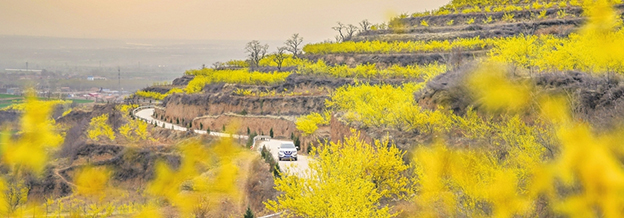
Aboriginal plants such as forsythia are used to preserve ecology in Shanxi, as they can protect soil from washed away by rains.HU BO / FOR CHINA DAILY
Aboriginal plants such as forsythia are used to preserve ecology in Shanxi, as they can protect soil from being washed away by rains.
Late September is harvest season for sea buckthorn fruit in Fangshan county in the west of Shanxi.
Zhao Gaiping, a resident in Huicun village, was busy collecting the yellow or orange-colored fruit that scattered on the slopes of Lyuliang Mountains.
"Selling the fruit to local wine or herbal tea producers is an important source of my family income,"Zhao said.
With rich content of various vitamins and amino acids, sea buckthorn is a favorite ingredient for producers. Herbal tea made from the leaves help with digestion, lowering blood fat and blood pressure.
However, in the eyes of local officials, the sea buckthorn goes beyond healthy food. It's also used for the protection of the environment.
Due to a reduction in vegetation coverage over the past few decades, Fangshan is among the regions of weakest ecology in Shanxi. Water erosion has presented severe challenges that have required generations of locals to tackle, said Wang Jinfeng, Party secretary of the county.
"In our decades' practice in improving the environment, we found that aboriginal plants like wild sea buckthorn can play a crucial role in protecting soil from being washed away by rains," Wang said.
The county began to plant sea buckthorn at the beginning of this century, and more than 13,000 hectares of the wild herb has been added to the mountains and hills in Fangshan, Wang said.
The ecological environment has steadily improved during the past two decades, evidenced by growing vegetation coverage, clearer water and the increase of wild animals.
"In the Hengquan Reservoir area, birds like egrets and storks can be spotted all year round," said Liu Quanwang, a local farmer.
In Huozhou city in the southwest of Shanxi, officials and residents are hoping the plant wenguanguo, or shiny-leaf yellow-horn, will improve ecology and increase income.
Huozhou used to be one of the top coal-producing regions in Shanxi. During the province's shift from a coal-reliant to a diversified economy, the city is using wenguanguo to repair the ecology at its mining sites.
Due to its ability to resist coldness, drought and alkaline, wenguanguo has been used in many regions in China to prevent desertification.
Medicines and teas made from wenguanguo are good for reducing blood pressure, blood fat and blood sugar.
Zhang Hua, a local businessman in Huozhou, was the first person in the country to found a company engaged in the planting of wenguanguo to make herbal tea.
His company, Wenguanguo Technology, includes a wenguanguo farm of 40 hectares and a factory with an annual capacity of 10 metric tons of herbal tea.
The company currently employs dozens of people from local households.
"We are planning to enlarge the scale of the company with hopes of greening more barren hills and helping more farmers get rich,"Zhang said.
Guo Yanjie contributed to this story.
By YUAN SHENGGAO in